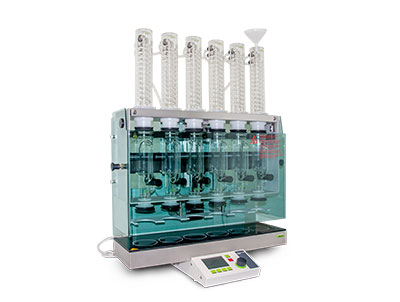
| OELCHECK test instrument: | Soxhlet extractor |
| Sample quantity: | approx. 10 g |
| Unit: | g |
| Test result: | amount of base oil extracted in % The viscosity is also determined using the base oil. Further OELCHECK analyses may also be performed by agreement. |
| Analysis for: | lubricating greases |
| Brief description: | The extractor consists of three sections. The lower section is a round-bottomed flask containing the solvent. The Soxhlet attachment is the central section of the apparatus. It contains the extraction sleeve, which is filled with the grease. The sleeve is made from latex. The base oil can diffuse through this material along with the solvent, while solid parts and thickening agent components remain in the sleeve. A water-cooled condenser is placed on the Soxhlet attachment. n-pentane is used as a solvent. During extraction, the solvent in the flask is heated and evaporated. The solvent vapour can pass the central section, i.e. the Soxhlet attachment, via a bypass and condense in the third, upper section of the apparatus. The solvent, which is liquid once again, drops back into the central section and fills the area containing the extraction sleeve with the solvent. The solvent is able to draw the base oil from the thickening agent through the latex sleeve. As solvent continues to evaporate and travel into the condenser in the central section, the liquid level continues to increase. From a certain level onwards, the solvent is returned to the lower glass flask via a vacuum lever mechanism. This procedure must be repeated until the base oil is almost completely dissolved out of the thickening agent. Once extraction is complete, the Soxhlet attachment is removed again and the solvent, which is already beginning to boil above room temperature, is evaporated out of the lower glass flask. Only the base oil, which boils at a considerably higher point, remains as a residue in the flask. The base oil yields and the thickening agent residue remaining in the extraction sleeve are then weighed and the result is given as base oil in % compared to the initial grease quantity weighed. The viscosity of the extracted base oil at 40 °C and 100 °C is then determined and the viscosity index is calculated. |
| Statement: | These two constituents can be investigated separately. In particular, it is possible to perform tests on the base oil that would not be possible with the formulated grease. The viscosity of the base oil can now be determined easily. Furthermore, an element analysis using ICP can provide information, for example, on the sulphur content of the base oil. The comparison between the base oil viscosity required for use and the base oil viscosity actually present in the lubricating grease provides crucial information on the structure of a hydrodynamic lubricating film and, accordingly, direct indications of the expected service life of a component. |
| Underlying test standard: | OELCHECK test method OPM 065 |